Innovative Water-Cooled Chiller Systems for Efficient Cooling Solutions in Modern Applications
Understanding Water-Cooled Chiller Systems
Water-cooled chiller systems play a crucial role in modern HVAC (heating, ventilation, and air conditioning) applications, serving industries and buildings that require effective temperature management. These systems use water as a cooling medium, allowing for efficient heat exchange and temperature regulation. In this article, we will explore the components, operation, advantages, and applications of water-cooled chiller systems.
Components of Water-Cooled Chiller Systems
A typical water-cooled chiller system consists of several key components
1. Chiller Unit The heart of the system, the chiller unit houses the compressor, evaporator, and condenser. The compressor is responsible for circulating refrigerant, while the evaporator absorbs heat from the indoor environment. The condenser, in this case, is cooled by water.
2. Cooling Tower This component dissipates heat from the condenser. It typically consists of a basin for water collection, a fan for air circulation, and fill media to enhance heat transfer efficiency.
3. Pumps Circulating pumps are necessary for moving water between the chiller, cooling tower, and the building's air handling units. They ensure constant flow and optimal performance of the system.
4. Piping Insulated piping systems transport chilled water to various parts of the building and return it for re-cooling. Proper sizing and insulation are critical to minimize energy loss.
5. Controls and Sensors Modern systems are equipped with advanced controls and sensors that continuously monitor temperature, pressure, and flow rates, optimizing system performance and ensuring energy efficiency.
How Water-Cooled Chiller Systems Work
The operation of a water-cooled chiller system begins with the compressor, which compresses the refrigerant and raises its pressure and temperature. The high-pressure refrigerant gas then flows into the condenser, where it releases heat to the cooling water. As the water circulates through the condenser, it absorbs heat, cooling the refrigerant, which condenses into a liquid state.
water cooled chiller system

The cooled refrigerant then enters the evaporator where it absorbs heat from the indoor air, evaporating back into a gas as it removes heat from the building. This cycle continues, transferring heat from the indoor environment to the water, which is subsequently cooled by the cooling tower. The cooling tower releases the absorbed heat into the atmosphere, allowing the water to return to the chiller in a cooled state.
Advantages of Water-Cooled Chiller Systems
Water-cooled chillers offer several advantages over air-cooled systems
1. Energy Efficiency Water has a higher heat capacity than air, allowing for more efficient heat exchange. This translates into lower energy consumption, especially in large cooling applications.
2. Reduced Noise Water-cooled systems tend to be quieter than their air-cooled counterparts, making them suitable for environments where noise reduction is vital.
3. Space Savings While they require more infrastructure, water-cooled chillers can be more compact than air-cooled systems, freeing up valuable outdoor space.
4. Longevity and Reliability Water-cooled chillers generally have longer lifespans and require less maintenance, resulting in lower long-term operational costs.
Applications of Water-Cooled Chiller Systems
Water-cooled chillers are widely used in commercial buildings, manufacturing facilities, hospitals, and data centers where controlled climate conditions are critical. They are essential for industrial processes, refrigeration, and large-scale cooling systems, making them a backbone of modern infrastructure.
In conclusion, water-cooled chiller systems are an integral part of efficient temperature management in various applications. Their energy efficiency, reliability, and effective heat transfer capabilities make them irreplaceable in the quest for sustainable and comfortable environments. As technology advances, we can expect further innovations in chiller design, enhancing their efficiency and expanding their applications even further.
















































































































